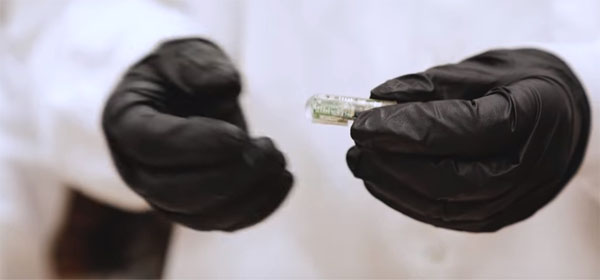Scientists have developed a capsule packed with tiny electronics and living cells that can spot health problems from within the gut.
Researchers from the Massachusetts Institute of Technology (MIT) built an ingestible sensor with genetically engineered bacteria that can diagnose bleeding in the stomach or other gastrointestinal problems.
This “bacteria-on-a-chip” approach combines sensors made from living cells with ultra-low-power electronics that convert the bacterial response into a wireless signal that can be read by a smartphone.
“By combining engineered biological sensors together with low-power wireless electronics, we can detect biological signals in the body and in near real-time, enabling new diagnostic capabilities for human health applications,” says Timothy Lu, an MIT associate professor.
In a study published in the Science journal, the researchers created sensors that respond to heme, a component of blood, and showed that they work in pigs. They also designed sensors that can respond to a molecule that is a marker of inflammation.
In the past decade, synthetic biologists have made great strides in engineering bacteria to respond to stimuli such as environmental pollutants or markers of disease. These bacteria can be designed to produce outputs such as light when they detect the target stimulus, but specialised lab equipment is usually required to measure this response.
To make these bacteria more useful for real-world applications, the MIT team decided to combine them with an electronic chip that could translate the bacterial response into a wireless signal.
“Our idea was to package bacterial cells inside a device,” lead author Phillip Nadeau says. “The cells would be trapped and go along for the ride as the device passes through the stomach.”
For their initial demonstration, the researchers focused on bleeding in the gastrointestinal tract. They engineered a probiotic strain of E. coli to express a genetic circuit that causes the bacteria to emit light when they encounter heme.
The researchers also built an Android app that could analyse the data.
The sensor, which is a cylinder about 38mm long, requires about 13 microwatts of power. The researchers equipped the sensor with a 2.7-volt battery, which they estimate could power the device for about 1.5 months of continuous use.
The researchers tested the ingestible sensor in pigs and showed that it could correctly determine whether any blood was present in the stomach.
They anticipate that this type of sensor could be either deployed for one-time use or designed to remain in the digestive tract for several days or weeks, sending continuous signals.
Currently, if patients are suspected to be bleeding from a gastric ulcer, they have to undergo an endoscopy to diagnose the problem, which often requires the patient to be sedated.
To help move the technology toward patient use, the researchers plan to reduce the size of the sensor and to study how long the bacteria cells can survive in the digestive tract. They also hope to develop sensors for gastrointestinal conditions other than bleeding.
Watch the sensor at work here:
Read more at mit.edu
Related articles:
Five ways to improve gut health
The truth about midlife weight gain
Food experts still split on gluten

